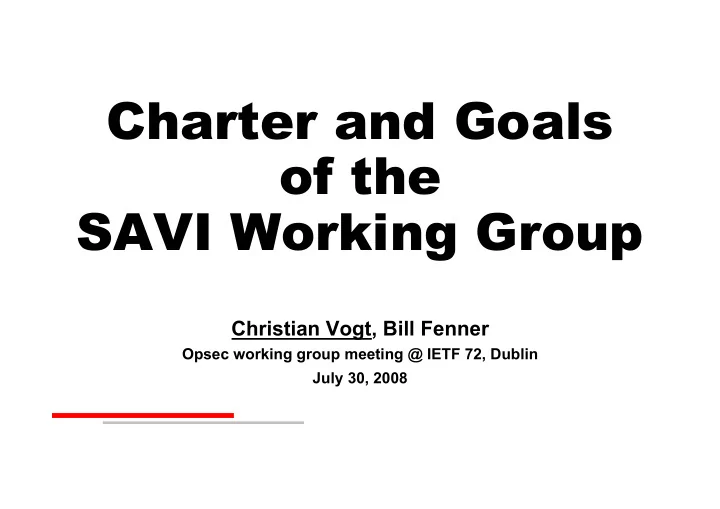

Charter and Goals of the SAVI Working Group Christian Vogt, Bill Fenner Opsec working group meeting @ IETF 72, Dublin July 30, 2008
Source Address Validation – Why Do We Need It? Internet fails to prevent IP source address spoofing packet delivery based on IP destination address only IP source address used by receiver, network entities sender identification destination for return traffic resulting threats illegitimate authorization to service circumvent accounting identity/location spoofing redirect unwanted traffic to 3 rd party 1
Existing Solutions ingress filtering Unicast Reverse Path Forwarding + variants Cisco IPv4 Source Guard not sufficient too coarse (IP address prefix validation at aggregated level) not standardized (as oftentimes demanded for procurement) M.I.T. Spoofer project provides evidence spoofing possible in ¼ of observed IP address space need additional protection – standardized 2
Possible Solution Scopes on local link within administrative domain across administrative domains envisioned benefits in focus area detect misconfigurations locally trace IP spoofing attacks IP-address-based authorization/accounting location identification 3
SAVI Goals and Requirements ensure that hosts attached to the same IP link cannot spoof each other's IP addresses without disrupting legitimate traffic for Ethernet or Ethernet-based broadband observe/use existing protocols no host changes for IPv4 and IPv6 for all address configuration methods preferably auto-configuring 4
Deliverables Aug 08 first working group draft on threats document Oct 08 first working group draft on IPv4 solution Oct 08 first working group draft on IPv6 solution Oct 08 submit document on threats to IESG for Informational RFC Feb 09 first working group draft on solution for Ethernet- based broadband access network Mar 09 submit IPv4 solution to IESG for Proposed Standard May 09 submit IPv6 solution to IESG for Proposed Standard Oct 09 submit Ethernet-based broadband access network solution to IESG for Proposed Standard 5
Framework for SAVI Solutions 1 st hop access router host SAVI solution IP address → lower-layer entity binding 1. derive legitimate IP address from on-link traffic 2. bind legitimate IP address to lower-layer entity 3. enforce binding 6
Challenges multiple IP addresses per interface multiple link layer addresses per interface host mobility at link layer hosts with multiple interfaces on same link routers address translators anycast addressing SAVI solution can be “default-on” only if it never disrupts legitimate traffic despite these challenges 7
Functional Components binding binding cache association between IP source memory that stores verified address and lower-layer entity bindings to avoid repeated binding verification binding conflict binding anchor when a packet’s IP source lower-layer entity in a binding address is in binding cache, but with different binding anchor binding verification binding conflict resolution method for verifying a binding method for handling a binding conflict 8
Degrees of Freedom which binding anchor? switch port link layer address which binding verification? check sending host (direct) ask other hosts (indirect) which binding conflict resolution? drop packets that cause a binding conflict re-verify on binding conflict 9
Analysis multiple interfaces multiple on same link IP addresses binding multiple binding mobility routers conflict link layer address anycast verification at link layer resolution addresses addressing translator yes no drop (switch port) (switch port) yes no no no yes check packet (L2 address) (L2 address) sending host binding anchor re-verify (direct) yes yes yes yes no binding yes no drop (switch port) (switch port) yes no yes no yes ask packet (L2 address) (L2 address) other hosts yes re-verify (switch port) (indirect) yes yes no yes no binding (L2 address) 10
Next Steps follow up on mailing list… Which challenges must/can be addressed? Where in the taxonomy should SAVI aim? 11
Recommend
More recommend